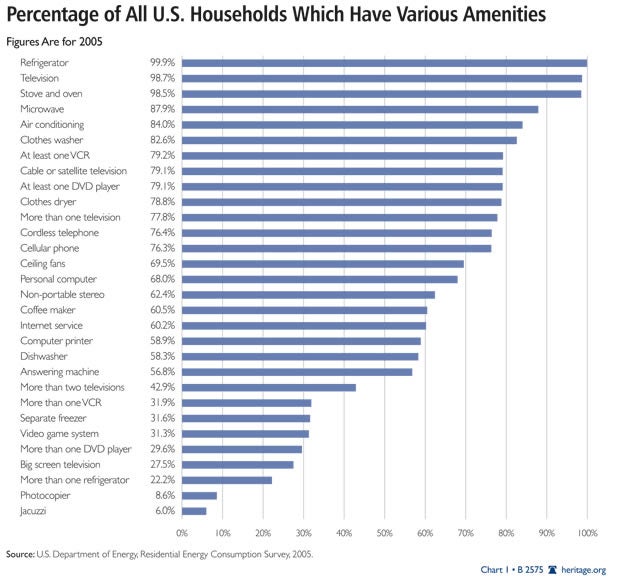As Congress struggles to find a way to cut spending as part of raising the $14 trillion debt ceiling, they should take a close look at the more than $1 trillion spent every year on welfare. You’ll be surprised to learn that many of the 30 million Americans defined as “poor” and in need of government assistance aren’t quite what you’d expect—rather than homeless and on the streets, the average poor American household has luxuries like air conditioning, cable TV, and X-box video game consoles.
In their new report, What Is Poverty?, The Heritage Foundation’s Robert Rector and Rachel Sheffield analyze what it really means to be poor in America. The reality they found is much different than the picture painted in movies and on TV:
According to the government’s own survey data, in 2005, the average household defined as poor by the government lived in a house or apartment equipped with air conditioning and cable TV. The family had a car (a third of the poor have two or more cars). For entertainment, the household had two color televisions, a DVD player, and a VCR.
If there were children in the home (especially boys), the family had a game system, such as an Xbox or PlayStation. In the kitchen, the household had a microwave, refrigerator, and an oven and stove. Other household conveniences included a washer and dryer, ceiling fans, a cordless phone, and a coffee maker.
The home of the average poor family was in good repair and not overcrowded. In fact, the typical poor American had more living space than the average European. (Note: That’s average European, not poor European.) The average poor family was able to obtain medical care when needed. When asked, most poor families stated they had had sufficient funds during the past year to meet all essential needs.
By its own report, the family was not hungry. The average intake of protein, vitamins, and minerals by poor children is indistinguishable from children in the upper middle class and, in most cases, is well above recommended norms. Poor boys today at ages 18 and 19 are actually taller and heavier than middle-class boys of similar age in the late 1950s and are a full one inch taller and 10 pounds heavier than American soldiers who fought in World War II. The major dietary problem facing poor Americans is eating too much, not too little; the majority of poor adults, like most Americans, are overweight.
That’s a far cry from the images the news media conjure up on TV. But it’s the reality of those who are defined as poor in America.
To be sure, the average poor family does not represent every poor family, and there are some who are better off and some who are worse off. Though most of the poor are well-housed, at any given point during the recession in 2009, about one in 70 poor persons was homeless, and one in five experienced temporary food shortages. Those individuals have serious concerns. But the fact remains that U.S. government statistics on poverty misrepresent the reality.
That misrepresentation has international implications. Rector and Sheffield explain that U.S. government poverty statistics portray a misleading negative image around the world. Al Jazeera, Iran’s Teheran Times, Chinese and Russian media have latched on to U.S. poverty statistics to depict the United States as a failed, nightmarish society. And nothing could be further from the truth.
President Obama plans to make this situation worse by creating a new “poverty” measure that deliberately severs all connection between “poverty” and actual deprivation. Rector and Sheffield say that the goal is to measure income “inequality,” not poverty—giving the President public relations ammunition for his “spread-the-wealth” agenda.
Rector and Sheffield write that when it comes to making policy, the broader reality of what poverty in America means should be taken into consideration: “Sound public policy cannot be based on faulty information or misunderstanding . . . In the long term, grossly exaggerating the extent and severity of material deprivation in the U.S. will benefit neither the poor, the economy, nor society as a whole.”
Read the full paper What Is Poverty?
Quick Hits:
- Republicans in the House and Senate are pushing for a constitutional amendment to balance the budget amid continuing efforts to cut a deal to raise the federal debt ceiling in exchange for $1.5 trillion in budget cuts.
- The Obama Administration has issued a new batch of Obamacare waivers. Of the 40,000 individuals exempted, nearly nine in 10 belong to union plans.
- The Taliban has claimed responsibility for the killing on Sunday of a senior adviser to Afghan President Hamid Karzai, a member of parliament, and several security guards.
- Al-Qaeda in Yemen has provided weapons, fighers and training with explosives to a militant Islamic group battling for power in Somalia, according to new American intelligence.
- The McConnell plan to hike the debt limit has only one thought behind it—fade the political heat. Read more about it on Foundry.org.


































150 Replies to “Morning Bell: What Is Poverty in America?”